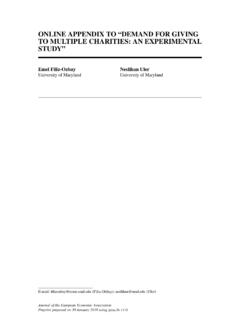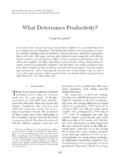Transcription of Cross-Country Differences in Productivity: The Role of ...
1 American Economic Review 2013, 103(1): 305 334 Differences in productivity : the role of Allocation and Selection By Eric bartelsman , john haltiwanger , and stefano Scarpetta*This paper investigates the effect of idiosyncratic ( firm-level) policy distortions on aggregate outcomes. Exploiting harmonized firm-level data for a number of countries, we show that there is substantial and systematic Cross-Country variation in the within-industry covariance between size and productivity . We develop a model in which heterogeneous firms face adjustment frictions (overhead labor and quasi-fixed capital) and distortions. The model can be readily calibrated so that variations in the distribution of distortions allow matching the observed Cross-Country moments. We show that the Differences in the distortions that account for the size- productivity covariance imply substantial Differences in aggregate performance.
2 (JEL D24, L25, O47)A vast theoretical and empirical literature has been devoted to identify the sources of the large and persistent Differences in productivity across countries. At the same time, a parallel strand of research has emerged over the past decade suggesting large and persistent heterogeneity in firm-level productivity , even in narrowly defined industries, in a variety of countries ( , bartelsman , haltiwanger , and Scarpetta 2004).A few recent papers have tried to combine these two strands of research by shed-ding light on how Cross-Country Differences in economic outcomes relate to dif-ferences in the within-industry productivity dispersion across firms. For example, recent papers explore the interplay between the heterogeneity in firm-level produc-tivity, the business environment, and aggregate economic performance (see, , Restuccia and Rogerson 2008; Hsieh and Klenow 2009; Alfaro, Charlton, and Kanczuk 2008; and Midrigan and Yi Xu 2010).
3 A common element of this emerging literature is that heterogeneity in firm-level productivity performance may indicate misallocation of resources across firms with negative effects at the aggregate level. * bartelsman : Department of Economics, Vrije Universiteit, Amsterdam, Netherlands, Tinbergen Institute, and IZA (e-mail: haltiwanger : Department of Economics, University of Maryland, College Park, MD 20742, NBER and IZA (e-mail: Scarpetta: OECD, 2 Rue Andre Pascal, 75016, Paris, France, and IZA (e-mail: We are indebted for many useful comments on earlier drafts and presentations to Susanto Basu, Mary Hallward-Driemeier, john Fernald, Chang-Tai Hsieh, Pete Klenow, Ariel Pakes, Amil Petrin, john Sutton, and two anonymous referees, as well as to the participants of the World Bank Conferences on the Microeconomics of Growth and on Firm Dynamics and the NBER Summer Institute. We thank the International Growth Centre, the World Bank, EU COST, and the OECD for financial sup-port.)))
4 We thank Ana Abras and Brock Williams for excellent research assistance. The views expressed in this paper are those of the authors and should not be held to represent those of the OECD or its member countries. To view additional materials, visit the article page at AMERICAN ECONOMIC REVIEWFEBRUARY 2013 However, an open question is which measures of firm-level heterogeneity are most instructive for detecting possible misallocation. Hsieh and Klenow (2009) argue, for example, that higher dispersion of productivity across firms within a given industry in China and India relative to the United States reflects greater misallocation of resources in China and paper provides a contribution to this line of research along two broad lines. First, we argue, both theoretically and empirically, that the within-industry covari-ance between size and productivity is a robust measure to assess the impact of mis-allocation. Second, we extend recent theoretical models to allow for distortions to play a role not only in the allocation of resources amongst existing firms but also in the selection of firms in the market and in the degree of firm motivation for our approach is that the empirical evidence from firm-level data has shown that the widespread heterogeneity in firm-level performance is accompanied by substantial heterogeneity in the size of firms, even within narrowly defined industries.
5 Moreover, consistent with core models of the size distribution of firms ( , Lucas 1978 and Melitz 2003), there is evidence in the firm-level data that the distributions of productivity and size exhibit a positive correlation that is to say, more productive firms tend to be larger than less productive ones. However, our Cross-Country data suggest that there is considerable variation in the strength of the link between productivity and size across countries and industries and over time. The working hypothesis of this paper is that policy-induced distortions may be the source of the observed variation in this covariance across countries and that this contributes to explaining observed Differences in aggregate misallocation hypothesis is not new (see, , the handbook paper by Banerjee and Duflo 2005 for a review) but the development of firm-level databases in a variety of countries now permits exploring this hypothesis more directly.
6 In this paper, we explore the misallocation hypothesis using a variety of moments drawn from a harmonized firm-level database for the United States and a number of European countries, including transition economies of Central and Eastern Europe. Our focus is to assess the extent to which distortions can account for the observed Differences across countries and over time in the within-industry productivity dis-persion, as discussed by Hsieh and Klenow (2009), and in our preferred measure of the covariance between productivity and size. Further, we emphasize that distortions affect not only the allocation of resources across firms, but also the selection of firms producing in each quantify the within-industry covariance between size and productivity , we use an established empirical decomposition of the level of industry productivity as pro-posed by Olley and Pakes (1996) henceforth, OP. The OP decomposition splits an index of industry-level productivity , defined as the weighted average of firm-level (log-) productivity , into an unweighted firm-level average and a covariance term.
7 The covariance term is a summary measure of the within-industry cross sectional covariance between size and productivity . In our analysis, we find that the OP cova-riance term for labor productivity averages about 50 log points within US manu-facturing industries. In an accounting sense, this implies that the industry index of labor productivity in the average US manufacturing industry is 50 percent higher than it would be if employment shares were randomly allocated within industries. However, the OP covariance term reaches only 20 30 log points in Western Europe, 307 bartelsman ET AL .: Cross-Country Differences IN PRODUCTIVITYVOL. 103 NO. 1and it was close to zero, if not negative, in Central and Eastern European countries at the beginning of their transition to a market economy. Quite remarkably, however, in these latter countries the covariance term increased substantially in the 1990s as their transition to a market economy use of the OP covariance term to explore the role of market distortions is, of course, not new.
8 In their seminal contribution, OP found that the covariance term (using a decomposition of industry Total Factor productivity , TFP) increased sub-stantially in the US telecommunications equipment industry following the dereg-ulation of the sector in the early 1980s. They argued that this was because the deregulation permitted outputs and inputs to be reallocated more readily from less productive to more productive US focus our analysis on three moments of the firm-level distributions, namely the within-industry standard deviations of labor productivity and of total factor productivity , and the within-industry covariance between labor productivity and employment shares. The individual moments, as well as the relationship between them, prove instructive in assessing the role of misallocation and this class of mod-els. We find that the within-industry dispersion of labor productivity is larger than the within-industry dispersion of total factor Our database of harmo-nized moments shows that this finding is robust across the countries, industries, and time periods finding is difficult to reconcile with many of the standard models in the literature, insofar as they have specific features that do not allow for any disper-sion in labor productivity .
9 In particular, the production function is often assumed to be Cobb-Douglas or, more generally, has the property that the average product of labor is proportional to the marginal product of labor. Moreover, many models make assumptions so that profit-maximizing firms equate the marginal revenue product of labor to the market wage. These two assumptions together imply that there should be no dispersion in labor productivity within industries (in the absence of distor-tions), even if there is significant dispersion in physical TFP. Our model includes frictions such as overhead labor that, interacted with quasi-fixed capital, allow for the dispersion in labor productivity to be larger than the dispersion in TFP, even in the absence of accounting for these features, we are careful to distinguish between physical and revenue based measures of productivity in the model and the data, as empha-sized in the recent literature (Foster, haltiwanger , and Syverson 2008 and Hsieh and Klenow 2009).
10 In particular, the frictions in our model imply that even in the absence of distortions there will be substantial dispersion in revenue based measures of labor productivity and total factor productivity and that each of these alternative measures of productivity will be positively correlated with each other. A further implication is that the core prediction from models of firm heterogeneity of a posi-tive covariance between physical output and physical productivity extends to predic-tions of a positive covariance between measures of size and productivity using the revenue based measures of Syverson (2004b) reports that, within narrowly defined industries, the difference in the United States between the ninetieth and the tenth percentiles of the firm-level productivity distributions is about 99 log points for total fac-tor productivity (TFP) and about 140 log points for labor AMERICAN ECONOMIC REVIEWFEBRUARY 2013 Furthermore, our simple model allows comparing and contrasting the effect of distortions on different moments in the data.







